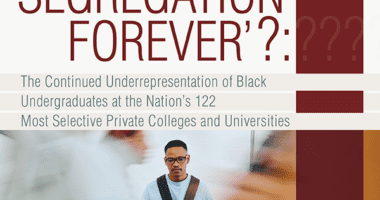The Education Trust releases College Results Online: Similar institutions aren’t that similar when it comes to student success
(Washington, DC) At a time when high school seniors around the country are busy applying to college, the Education Trust today released an interactive Web tool and two reports that challenge the conventional wisdom about college-graduation rates.
The user-friendly Web tool, College Results Online, points to glaring disparities in college completion among very similar schools.
The online tool, found at www.collegeresults.org, allows users to select any four-year public or private nonprofit college or university in the country and see how its graduation rates compare with similar institutions that serve similar student populations. It also allows users to examine graduation rates broken down by students race, ethnicity, and gender. This information, which only recently became available to the public, reveals significant gaps in graduation rates between White students and students of color at most colleges and universities.
The Education Trusts analysis makes it clear that far too many students start college and dont finish. Every year, about a million first-time, full-time freshmen head into four-year colleges seeking degrees. Fewer than four in 10 will meet that goal within four years, and barely six in 10 will make it in six years.
While theres still lots of work to do to make sure more young people have access to college, its clear that what happens once they get to college matters, too, said Kati Haycock, director of the Education Trust.
The analysis finds that graduation rates are much worse for minority students. Even, when they attend the same schools, students of different racial and ethnic backgrounds face very different graduation prospects. At one in four American colleges, the Black-White graduation gap is staggeringly large: 20 percentage points or higher.
But College Results Online also offers good news. Throughout the country, there are colleges and universities that have steadily increased overall graduation rates, that graduate minority students at nearly the same rates as White students, and that consistently outperform similar schools.
Some colleges and universities have put student success at the heart of their missions and are making a difference in the lives of their students, Haycock said. We need more to follow their example.
The Education Trust used the online tool to identify some of these schools, and we interviewed administrators to learn more about what distinguishes them. That work is the focus of the reports released today. The first, One Step from the Finish Line: Higher College-Graduation Rates are Within Our Reach, explains College Results Online, guides readers on how to use it and highlights the strategies of some successful colleges and universities.
The second report, Choosing to Improve: Voices from Colleges and Universities with Better Graduation Rates, offers a more detailed examination of the practices of these schools and outlines a growing body of research that tells us that what schools do matters a great deal — from their efforts to keep new students engaged to their use of data to uncover obstacles to completion.
The critically important focus on institutional policies and practices is not intended to diminish the significance of focusing on other barriers to college completion. Factors like the academic preparation of students, the availability of financial aid, and the dollars on hand for instruction and student advising influence graduation rates. But the Education Trust analysis found that even when we control for these factors, some colleges and universities do far better than other schools that are quite similar.
For far too long, we have blamed low graduation rates only on the students. This sort of thinking has led us to believe that there is nothing that colleges and universities could do to help more students graduate, said Kevin Carey, director of policy research at the Education Trust.
This thinking is dead wrong, he said. As College Results Online shows us, some schools are doing a whole lot better than other, similar schools in serving their students.
Among the schools highlighted in our report:
- St. Mary’s University in San Antonio, Texas, where 75 percent of students are Latino, has an overall graduation rate of 63.3 percent a rate that exceeds that of similar schools and is higher than many other Hispanic Serving Institutions.
- Florida State University, which has virtually closed the gap in graduation rates between African-American and White students.
- Alcorn State University, a Historically Black College in Mississippi, which has improved its six-year graduation rate significantly in recent years — to the point that it is about 10 percentage points higher than the median rate of similar institutions.
- The University of Northern Iowa, which consistently has one of the highest graduation rates in the nation among public, Masters-granting institutions. Its six-year graduation rate was 65.1 percent in 2003. The median graduation rate at its 25 most similar institutions was 53.3 percent.
Altogether, College Results Online allows users to examine graduation rates at 1,400 colleges and universities around the country. College Results is drawn from the nations most comprehensive database of institutional graduation rates, the U.S. Department of Educations Graduation Rate Survey.
Because institutions and the students they serve vary widely, the analysis compares schools with those that are most similar, based on 11 factors that are statistically related to graduation rates. Those factors range from median scores on college-admissions exams to the percentage of students receiving federal Pell Grants.
These reports and Web tool are part of the Education Trust’s new effort to focus on the policies and practices in higher education that will yield better graduation rates for all students, but particularly for minority students and those from low-income families. The Education Trust has joined forces with the American Association of State Colleges and Universities (AASCU) and the National Association of System Heads (NASH), and launched a study of high-performing colleges and universities to identify practices other campuses can use to improve graduation rates.
“The American Association of State Colleges and Universities congratulates the Education Trust on its development of a new Web tool to assist in understanding graduation rates,” said Constantine W. (Deno) Curris, president of AASCU. “Graduation rates have sometimes been used inappropriately to compare students and institutions and the new tool will provide more reasonable comparisons.
“We are also pleased to have joined with Ed Trust and the National Association of System Heads in a national graduation rate study involving more than 100 of our institutions to identify the factors and strategies that contribute to improved graduation rates.”
The Education Trust will regularly update College Results Online (www.collegeresults.org) with the latest federal and state graduation data, providing policymakers, the public and students themselves with a new tool to evaluate the nations four-year colleges and universities.
###
The Education Trust works for the high academic achievement of all students at all levels, kindergarten through college, and forever closing the achievement gaps that separate low-income students and students of color from other youth. Our basic tenet is this All children will learn at high levels when they are taught to high levels.









